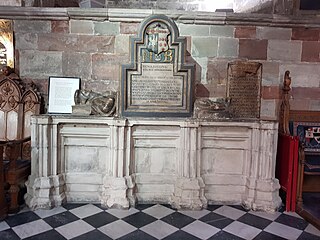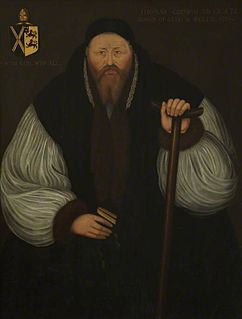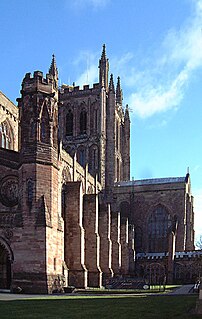Related Research Articles

Nicholas Bullingham was an English Bishop of Worcester.
Bullingham is a surname, and may refer to:
John Scory was an English Dominican friar who later became a bishop in the Church of England.

The Diocese of Gloucester is a Church of England diocese based in Gloucester, covering the non-metropolitan county of Gloucestershire. The cathedral is Gloucester Cathedral and the bishop is the Bishop of Gloucester. It is part of the Province of Canterbury.

The Bishop of Gloucester is the ordinary of the Church of England Diocese of Gloucester in the Province of Canterbury.

Thomas Godwin was an English bishop, who presided over the Diocese of Bath and Wells.

Richard Swinefield was a medieval Bishop of Hereford, England. He graduated doctor of divinity before holding a number of ecclesiastical offices, including that of Archdeacon of London. As a bishop, he dedicated considerable efforts to securing the canonisation of Thomas de Cantilupe, his predecessor, for whom he had worked during his lifetime. Active in his diocese, he devoted little time to politics. He was buried in Hereford Cathedral where a memorial to his memory still stands.

Godfrey Goldsborough was a Church of England clergyman and bishop of Gloucester from 1598-1604. He was educated at Trinity College, Cambridge. He also served as a Prebendary of Worcester.

George Coke or Cooke was successively the Bishop of Bristol and Hereford. After the battle of Naseby in 1645, Hereford was taken and Coke was arrested and taken to London. He avoided charges of High Treason in January 1646 and died in Gloucestershire that year.
Robert Bennet (Bennett) was an English Anglican bishop and the Dean of Windsor.
Rowland Meyrick (Merrick) (1505–1566) was a Welsh bishop of Bangor.
Richard Cheyney was an English churchman, bishop of Gloucester from 1562. Opposed to Calvinism, he was an isolated and embattled bishop of the reign of Elizabeth, though able to keep his see.
Paul Bush was an English Augustinian and first bishop of Bristol of the new diocese.
John Woolton served as Bishop of Exeter in Devon, England, from 1579 to 1594.
Richard de Abyndon, Abendon, or Abingdon was an English judge.

The Bishop of Bristol heads the Church of England Diocese of Bristol in the Province of Canterbury, in England.
John Fuller was the master of Jesus College, Cambridge. As bishop's chancellor in Ely, Cambridgeshire, he was charged with suppressing Christian heresy, condemning several heretics to be burnt at the stake.

The Dean and Chapter of St Paul's Cathedral was the titular corporate body of St Paul's Cathedral in London up to the end of the twentieth century. It consisted of the dean and the canons, priests attached to the cathedral who were known as "prebendaries" because of the source of their income. The Dean and Chapter was made up of a large number of priests who would meet "in chapter", but such meetings were infrequent and the actual governance was done by the Administrative Chapter headed by the dean, made up of several senior "residentiary canons", who were also known as the "Dean and Canons of St Paul’s" or simply "The Chapter".
Arthur Saul was an English Puritan cleric and academic, a Marian exile and canon of Gloucester Cathedral.
John Howorth, D.D. was a 17th-century priest and academic.
References
 This article incorporates text from a publication now in the public domain : "Bullingham, John". Dictionary of National Biography . London: Smith, Elder & Co. 1885–1900.
This article incorporates text from a publication now in the public domain : "Bullingham, John". Dictionary of National Biography . London: Smith, Elder & Co. 1885–1900.